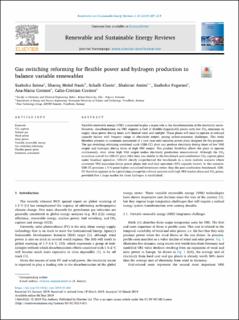| dc.contributor.author | Szima, Szabolcs | |
| dc.contributor.author | Nazir, Shareq Mohd | |
| dc.contributor.author | Cloete, Schalk Willem Petrus | |
| dc.contributor.author | Amini, Shahriar | |
| dc.contributor.author | Fogarasi, Szabolcs | |
| dc.contributor.author | Cormos, Ana-Maria | |
| dc.contributor.author | Cormos, Calin-Cristian | |
| dc.date.accessioned | 2020-04-27T07:51:07Z | |
| dc.date.available | 2020-04-27T07:51:07Z | |
| dc.date.created | 2019-05-09T13:38:30Z | |
| dc.date.issued | 2019 | |
| dc.identifier.citation | Renewable & Sustainable Energy Reviews. 2019, 110 207-219. | en_US |
| dc.identifier.issn | 1364-0321 | |
| dc.identifier.uri | https://hdl.handle.net/11250/2652544 | |
| dc.description.abstract | Variablerenewableenergy(VRE)isexpectedtoplayamajorroleinthedecarbonizationoftheelectricitysector.However, decarbonization via VRE requires a fleet of flexible dispatchable plants with low CO2emissions tosupplycleanpowerduringtimes withlimitedwindandsunlight.Theseplantswillneedtooperateatreducedcapacity factors with frequent ramps in electricity output, posing techno-economic challenges. This studythereforepresentsaneconomicassessmentofanewnear-zeroemissionpowerplantdesignedforthispurpose.The gas switching reforming combined cycle (GSR-CC) plant can produce electricity during times of low VREoutput and hydrogen during times of high VRE output. This product flexibility allows the plant to operatecontinuously, even when high VRE output makes electricity production uneconomical. Although the CO2avoidancecostoftheGSR-CCplant(€61/ton)wassimilartothebenchmarkpost-combustionCO2captureplantunder baseload operation, GSR-CC clearly outperformed the benchmark in a more realistic scenario wherecontinued VRE expansion forces power plants into mid-load operation (45% capacity factor). In this scenario,GSR-CCpromisesa5%-pointhigherannualizedinvestmentreturnthanthepost-combustionbenchmark.GSR-CCthereforeappearstobeapromisingconceptforafuturescenariowithhighVREmarketshareandCO2prices,provided thatalargemarket forcleanhydrogenisestablished | en_US |
| dc.language.iso | eng | en_US |
| dc.publisher | Elsevier | en_US |
| dc.rights | Attribution-NonCommercial-NoDerivatives 4.0 Internasjonal | * |
| dc.rights.uri | http://creativecommons.org/licenses/by-nc-nd/4.0/deed.no | * |
| dc.title | Gas switching reforming for flexible power and hydrogen production to balance variable renewables | en_US |
| dc.type | Peer reviewed | en_US |
| dc.type | Journal article | en_US |
| dc.description.version | publishedVersion | en_US |
| dc.source.pagenumber | 207-219 | en_US |
| dc.source.volume | 110 | en_US |
| dc.source.journal | Renewable & Sustainable Energy Reviews | en_US |
| dc.identifier.doi | 10.1016/j.rser.2019.03.061 | |
| dc.identifier.cristin | 1696657 | |
| dc.description.localcode | https://doi.org/10.1016/j.rser.2019.03.061. Received15 January 2019; Received in revised form 19 March 2019; Accepted 30 March 2019. Corresponding author.E-mailaddress:shahriar.amini@sintef.no(S.Amini). Renewable and Sustainable Energy Reviews 110 (2019) 207–219 .Available online 06 May 20191364-0321/ © 2019 The Authors. Published by Elsevier Ltd. This is an open access article under the CC BY-NC-ND license (http://creativecommons.org/licenses/BY-NC-ND/4.0/). | en_US |
| cristin.ispublished | true | |
| cristin.fulltext | preprint | |
| cristin.fulltext | original | |
| cristin.qualitycode | 1 | |

